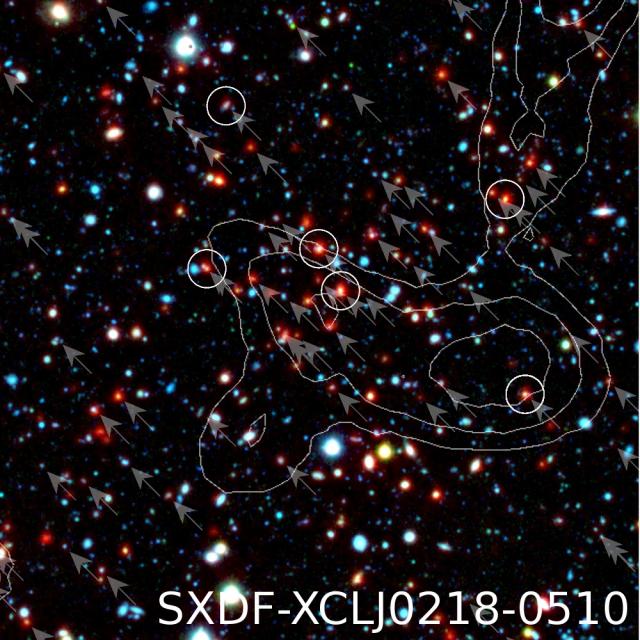Bad Astronomy - 10 May 2010
Astronomers have found the most distant galaxy cluster ever seen: the sexily-named SXDF-XCLJ0218-0510.
First, the picture, then the words:

Invisible light discovers the most distant cluster of galaxies (Subaru/XMM-Newton Deep Field)
Invisible light discovers the most distant cluster of galaxiesYikes! What’s all that then?
Okay, first, this picture is littered with stars and galaxies. The galaxies are so far away they’re hard to distinguish from the stars! The dots that have arrows pointing to them are the galaxies that are most likely part of the cluster. The ones with circles have had their distance measured and are known to be part of the cluster for sure. The contour lines represent the detection of very hot gas, which is a dead giveaway that we’re dealing with a cluster here; all big clusters have gas swirling around them that gives off X-rays; the lines are like a topographic map telling you where the (otherwise invisible) gas is in the picture.
"So what?", you might say. We’ve seen lots of clusters before. Ah, but this one is different: it’s a whopping 9.6 billion light years away.
Institute for the Physics and Mathematics of the Universe (IPMU) - 10 May 2010
Most distant galaxy cluster revealed by invisible lightDr. Masayuki Tanaka of the Institute for the Physics and Mathematics of the Universe (IPMU), Dr. Alexis Finoguenov of the Max Planck Institute for Extraterrestrial Physics, and Dr. Yoshihiro Ueda of Kyoto University discovered the most distant cluster of galaxies in the universe 9.6 billion light years away using light invisible to our eyes.
The universe hosts a multitude of galaxies. Galaxies are not uniformly distributed in the universe, but are arrayed in filamentary structures. Filaments permeate the universe and form a gigantic cosmic spider web. Galaxies clusters, where many galaxies live together, are often located at the knots of the filaments. The most distant cluster known – at least until now – is located some 9.2 billion light years away. A team of astronomers from Japan and Germany has discovered an even more distant cluster of galaxies using light invisible to human eyes.
Max Plank Institute for Extraterrestrial Physics (MPE) - 10 May 2010
The spectroscopically confirmed X-ray cluster at z=1.62 withAn international team of astronomers from Germany and Japan has discovered the most distant cluster of galaxies known so far - 9.6 billion light years away. The X-ray and infrared observations showed that the cluster hosts predominantly old, massive galaxies, demonstrating that the galaxies formed when the universe was still very young. These and similar observations therefore provide new information not only about early galaxy evolution but also about history of the universe as a whole.
Clusters of galaxies are the largest building blocks in the universe. Our galaxy, the Milky Way, is part of the Virgo cluster, comprising some 1000-2000 galaxies. By observing galaxies and clusters that are very distant from Earth, astronomers can look back in time, as their light was sent out a long time ago and took millions or billions of light-years to reach the astronomers´ telescopes.
An international team of astronomers from the Max Planck Institute for Extraterrestrial Physics, the University of Tokyo and the Kyoto University has now discovered the most distant cluster of galaxies observed so far. X-ray observations in the Subaru XMM Deep Field helped to identify the candidates, and infrared observations using the Subaru telescope provided the distance information. A particularity of this discovery consists in using infrared wavelengths, invisible to the naked eye. This is dictated by the expansion of the universe, which forces distant galaxies to have large velocities, shifting their light away from visible to infrared wavelengths. The Multi-Object Infrared Camera and Spectrometer (MOIRCS) at the Subaru telescope works at near-infrared wavelengths, where the galaxies are most luminous.
a possible companion in the Subaru/XMM-Newton deep field
- arXiv.org > astro-ph > arXiv:1004.3606 > 21 Apr 2010
Accepted for publication in The Astrophysical Journal Letters